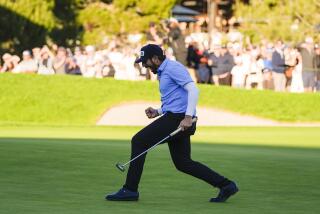Golf’s Early Season Star Will Be Hitting Them Where They Ain’t
- Share via
If it is past 7:09, and you are still sitting at your breakfast bar trying to kick start your eyelids with a cup of caffeine, you have missed perhaps the most obscure star of the 1990 PGA Tour departing the first tee at Torrey Pines North.
Who, you wonder, might this be?
Before you whip the newspaper askew in search of the pro-am starting times for the Shearson Lehman Hutton Open, let me tell you the pro with that group is Ed Fiori.
He’s not my man.
My man is the am, as in amateur.
My man is a two-time winner thus far in 1990, making him a startling early leader for golfer of the decade. He tied for first in the Bob Hope Chrysler Classic and won outright at the AT&T; Pebble Beach National Pro-Am.
No one else has won two of anything. Six different tournaments have produced six different winners, at least among the professionals.
My man the am is Dean Spanos, a La Jollan who spends 75% of his time in one job, 20% with another, 20% to 30% with a third and still has some time left to play the game of golf rather well.
The name, of course, is familiar. Dean Spanos is kind of the guy in the background for his high-profile father. He is president of Alex G. Spanos Construction, project syndicator for Spanos Enterprises and vice chairman of the Chargers, the most notable of Spanos’ enterprises hereabouts.
Dean’s the guy with the one-inch square picture on page 6 of the Charger media guide, just behind Pappa’s two-page spread and half-page picture on 4 and 5.
Background guy?
Dean tees off at 7:09 with Fiori and three guys named Jeff, Ken and Mike. Pappa tees off at 10:58 with Craig Stadler and three guys named Gerald Ford, Bob Hope and Leon Parma in what has become a traditional Torrey Pines pro-am pairing.
I’ll take Dean’s group and give Pop and Pals three a side.
After all, Dean Spanos is on a tear.
In a blind draw for partners at the Hope, he drew amateurs Jim Willingham of Los Angeles and Mal Kaufman of Chicago. Amateurs switch pros daily at the Hope, Spanos and Co. playing, in order, with Jim Hallet, Tom Sieckmann, Jay Haas and Brad Faxon.
“All the leaders were right together,” Spanos said. “We were never way ahead and never way behind. The last round we played Tamarisk with Brad Faxon. That was our best round, but I figured maybe we had finished second or third. I didn’t find out we’d tied for first until later that night.”
The AT&T; is a totally different program. One professional plays with one amateur for the first three rounds and the top 25 twosomes qualify for the final day, when many of them will be exposed to just a little bit of added tension.
National television.
“That,” said Spanos, “is more pressure than anyone can imagine. You don’t know if the cameras are on, but you always think they are. You’re so concerned that you don’t do anything embarrassing. It doesn’t faze the pros.”
Spanos and Hubert Green, his partner for the seventh year, were nine under after the first round and led by one but slipped behind while going four under the next day.
“Saturday’s round, we had the good fortune to play Spyglass,” he said.
Good fortune? Spyglass?
“It was a real windy day,” he said. “After the first five holes, we were back in the forest and it was kind of protected from the wind. We went 11 under to get to 24 under for three rounds.”
Dean Spanos had made the cut, as did his father, playing with Bobby Wadkins.
However, this was young Spanos’ time to hog the spotlight. He and Green came in four under to win by four shots . . . and win their second AT&T.; They had also won in 1985.
Dean Spanos learned the game from his father, but you know how youth can be about its time to be served.
“He’s still pretty tough,” young Spanos said, “but I think I’m a teeny bit better now. What you have to give him is that he never played until he was 30 and, in less than five years, he was a two-handicapper, and he qualified for the British Amateur.”
In those days, Alex Spanos was playing with bright lights from the Bay Area such as Ken Venturi, Tony Lema and John Brodie.
“He semi-retired to play golf,” Dean Spanos said. “When those guys turned pro, he went back to work. He thought there was more money to be made in the construction business.”
However, the construction business can be a rather anonymous place to be, unless a fellow does so well that he can afford to purchase an NFL team. That has gotten Alex Spanos a lot of attention, some of which he would rather do without.
Dean Spanos has not gotten much attention from his various roles with the various Spanos enterprises . . . and he didn’t really get much attention for his two pro-am victories.
The best way to find him today will be to look for the largest gallery on the course. That won’t be him. That will be his father. Then hustle up ahead a few holes and find someone with no one. That someone will likely be this year’s only two-time winner.
More to Read
Go beyond the scoreboard
Get the latest on L.A.'s teams in the daily Sports Report newsletter.
You may occasionally receive promotional content from the Los Angeles Times.










